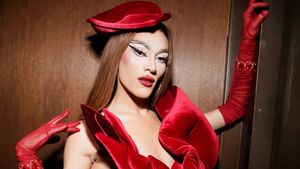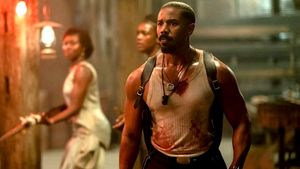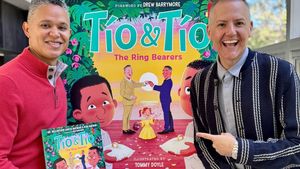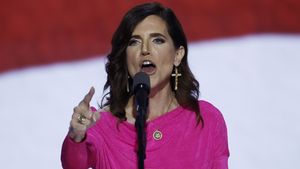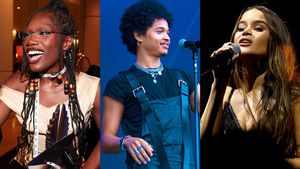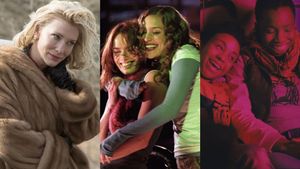Ariel Foxman | Magazine editor | 35 | New York City
Every February, InStyle magazine features a portfolio of the previous year's most glamorous celebrity weddings. This year that roundup was led off by glossy shots of Ellen DeGeneres and Portia de Rossi, both clad in white Zac Posen creations, posing at their August 2008 ceremony in Los Angeles.
Featuring DeGeneres and de Rossi "wasn't a decidedly bold move," says Ariel Foxman, the youthful managing editor of InStyle. "It's just the world we live in."
This may be a bit of false modesty from someone accustomed to receiving praise. Foxman was only 34 when he was named the top editor at InStyle, one of the nation's best-selling fashion magazines (he also oversees all 16 international editions of the magazine as well as InStyle Weddings ). Prior to that, the Harvard graduate honed his craft at Details and The New Yorker before launching the men's shopping magazine Cargo as its editor in chief at age 29.
"Being gay has been something I've been fortunate to be able to take for granted," Foxman says. "I think the visibility of out gay men in this realm of celebrity and fashion has allowed me to sort of slide into this position without much hoopla." But he doesn't dismiss the role the steady march of progress has played when it comes to his post. "Would I be in this position 10 or 15 years ago? Probably not."
Foxman's success may be traced to Psychology 101 -- the merits of positive thinking. "There was a ceiling at Cargo with age and perhaps a ceiling with being a male editor at InStyle, " he says. "But I never think about it that way. I always see [new jobs] as an opportunity to prove my ability." And for Foxman, that proof is in the numbers: Although overall magazine sales dropped a whopping 11% in the second half of 2008, newsstand sales of InStyle jumped 6%.
Ariel Levy | Writer | 34 | New York City
After 12 years as a writer for New York magazine, where she memorably chronicled such topics as lesbian "boi" culture, her own 2007 marriage, and -- in a devastating profile -- Clay Aiken, Ariel Levy jumped to The New Yorker last year, where her journalistic gifts are on national display. As always, Levy has cast a wide net, writing about the 1970s lesbian separatist group the Van Dykes, profiling fashion designers like Marc Jacobs and Lanvin's Alber Elbaz, and tackling trickier subjects like Cindy McCain, who Levy says refused to make eye contact with her when she interviewed McCain during the 2008 presidential campaign. Also to Levy's credit: the book Female Chauvinist Pigs, a bracing critique of female "raunch culture," which was published in 2005.
Being out has been good for her career -- even, perhaps, a factor in landing her New Yorker gig. "I wouldn't say I got my job because of affirmative action, but I certainly think it didn't hurt," Levy says. "I think they were psyched to have diversity." And being open about her sexual orientation has also allowed her to get certain interviews, like with Lamar Van Dyke, the idiosyncratic former leader of the Van Dykes. "If I'd gone to her and said 'I want to write about you, I'm straight,' she never would've said yes. And that was such a cool, weird story." And one that hadn't previously been told -- a true journalistic scoop.
Benoit Denizet-Lewis | Writer | 33 | Boston
Forty years ago it would not have been possible for a young journalist to make a name and a career for himself by writing about gay life for a mainstream news publication. But Benoit Denizet-Lewis, a contemporary journalist and author, has done just that, writing seminal articles for T he New York Times Magazine like "Double Lives on the Down Low."
"Being openly gay certainly didn't hurt my career," says Denizet-Lewis, who grew up in San Francisco not five minutes away from the Castro. As a young man in denial about his sexuality, he says he might as well have been 500 miles away. "As a kid I changed buses on the corner of Castro and Market, oddly enough, and I looked around and it was a lot of leather, and in my mind I didn't relate to that." Nevertheless, it makes him angry when he hears young people acknowledge that they're gay but then say that they don't relate to gay culture. "Their knee-jerk reaction [is to say] 'I am gay, but I am not like those girly guys,'E,f;" he says. "I always try to get people to understand that those drag queens were a lot braver than those [straight-acting] guys who are often too chickenshit to come out." Denizet-Lewis's book America Anonymous: Eight Addicts in Search of a Life came out earlier this year, and early next year he will publish a collection of his writing about gay and youth culture titled American Voyeur: Dispatches From the Far Reaches of Modern Life.
Ari Shapiro | Radio aEUR%0journalist | 30 | Washington, D.C.
Ari Shapiro, the justice correspondent for National Public Radio, always has a lot of things on his nimble mind, but being gay usually isn't one of them. "I'm undoubtedly where I am today only because people like Frank Kameny were trailblazers," he says. "Would I have been the same kind of trailblazer had I been in his shoes? I don't know. But I have the luxury of not having to be."
Shapiro is a different kind of pioneer, one who leads by example. In 2004 he wed his college boyfriend when San Francisco briefly legalized marriage equality. Shapiro's openness hasn't relegated him to the gay beat -- he occasionally serves as host of Morning Edition, and besides tracking the Department of Justice, he's covered hurricanes, prison abuses at Abu Ghraib, and domestic surveillance. But it was an undercover story on crystal meth abuse at gay bathhouses that won him the prestigious Daniel Schorr journalism award. And the story he calls his most challenging? A piece on Leslie Hagen, an attorney at the Justice Department fired over lesbian rumors. Hagen wouldn't participate in the story, and Shapiro was worried any misinformation could damage Hagen's career prospects. "With my job I can really change things for the better," Shapiro says. "But if I do something wrong, I can change the world -- or an individual's life -- for the worse."
Josh Rubin | Internet maven | 35 | New York City
If, as economic historians have long insisted, recessions and depressions foster invention and entrepreneurship, then Josh Rubin is in exactly the right place at the right time. The poly-hyphenate Rubin is a designer (of websites and interfaces, mobile software, Web apps, iPhone-friendly glovesaEUR|), consultant, new media publisher, editor, and trend forecaster. Of his many remarkable brainchildren -- also including his firm Bond Art + Science, with clients like W and F ast Company -- CoolHunting.com stands out. As a prescient, lovingly curated catalog of what's going to be hot in technology, art, design, and culture, and the technicians and artists responsible, the blog reflects the fluid, convergent nature of how we talk, play and create today. "I'm a designer, but I'm also a geek," Rubin says modestly. On a recent day his agenda included a meeting with a fashion client, code fixes for CoolHunting, some design work, calls, e-mails, and sprucing up the apartment in anticipation of a visit from the dog groomer. He lives with his business partner and husband, Evan Orenstein (they married in Toronto two years ago after eight years together), and their dogs, Otis and Logan. One thing the multitasking mogul doesn't have time for: the closet. "I don't think that I could do everything that I do if I wasn't out. I have enough going on in my head. The burden of having to stay in the closet would hold me back."
Rachel Maddow | Television & radio host | 36 | New York City
When Rachel Maddow scored her own MSNBC show during prime election season last September, she was the youngest anchor on the network. She was also the only one who was openly gay. But viewers quickly demonstrated that was fine by them -- in her first month she doubled the audience for the 9 p.m. hour. Fans enjoy her infectious personality, wry humor, and encyclopedic understanding of domestic and foreign policy. Maddow -- a Rhodes Scholar and onetime AIDS activist and morning radio sidekick -- delivers news analysis that reveals the mind of a junkie who not only loves politics but wants others to love it too.
Maddow gets plenty of antigay hate mail. "On any given right-wing website or blog, somewhere in the comments section someone is threatening to kill me because I'm gay," she says, calling it "part and parcel" of the routine since her first job in the media. But, she adds, she makes no special effort to emphasize gay issues on the show. "I was essentially a full-time activist or an activist and student or an activist and radio host for 14 years," she explains. When she started working at Air America radio in March 2004, Maddow sent an e-mail to all the prison reform and AIDS policy mailing lists in which she participated, saying, "I am dropping out of activism for a few months because I'm moving to New York and taking this job in media. Hopefully I'll be back in a few months when everything gets settled." The return never happened. "I am definitely not an activist now, and I miss it," she says, adding that she may go back one day. "I think it is possible to be an activist broadcaster. I just choose not to be."
Felix Burrichter | Architect and magazine editor | 30 | New York City
As the founding editor and creative director of Pin-Up, a "magazine for architectural entertainment," Felix Burrichter has combined fashion, sex, design, photography, and contemporary art editorial, all under the auspices of architectural theory. Architecture, he says, often gets wrapped up in its own pretension, and his magazine's sensibility is emancipating. Smart, offbeat analyses, interviews, and photo stories are wrapped in a succinct design that resembles the clean geometry of a Bauhaus-era art journal with the campy pastiche of a JCPenney catalog and the subversion of weekly escort advertisements. The title itself is also a clever hybrid, referencing both the heyday of erotic publications and the casual term for academic architectural critique.
"I kind think of Pin-Up as a guilty pleasure for architects," he says of the biannual magazine, which is winning favor with nonarchitects as well. "The majority of the architect profession is so hypermasculine. There's a concept of the alpha-male architect that I personally never fit into."
The profession has certainly seen its share of ego imposed by an unofficial cadre of straight white males, but Burrichter muses that this fraternity might evolve when more socially liberated junior architects come into positions of creative influence and helm their own firms. Until then, Burrichter will do his best to make blueprints blush red.

























